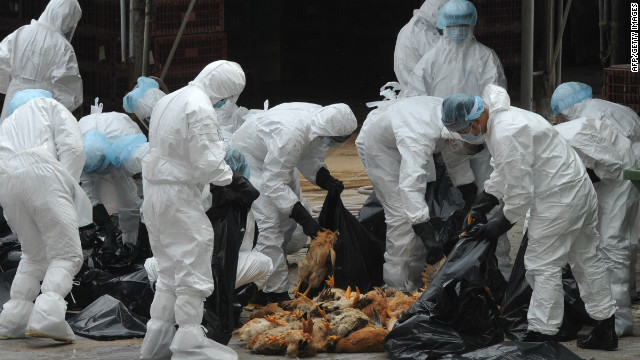Tag Archives: vaccines
PANDEMIC – Mystery illness in Cambodia solved, doctors say
 Phnom Penh, Cambodia (CNN) — The cause of a mysterious illness that has claimed the lives of more than 60 Cambodian children has been determined, medical doctors familiar with the investigation told CNN on Wednesday.
Phnom Penh, Cambodia (CNN) — The cause of a mysterious illness that has claimed the lives of more than 60 Cambodian children has been determined, medical doctors familiar with the investigation told CNN on Wednesday.
A combination of pathogens, disease-causing micro-organisms, is to blame for the illness, the World Health Organization, in conjunction with the Cambodian Ministry of Health, has concluded, the doctors said.
The pathogens include enterovirus 71, which is known to cause neurological disease; streptococcus suis, which can cause infections like bacterial meningitis in people who have close contact with pigs or with pork products; and dengue, which is transmitted by mosquitoes.
The inappropriate use of steroids, which can suppress the immune system, worsened the illness in a majority of the patients, the doctors said. The World Health Organization (WHO) is expected to advise health care workers to refrain from using steroids in patients with signs and symptoms of the infection, which include severe fever, encephalitis and breathing difficulties.
While not all the microorganisms were present in each patient, doctors concluded the illness was caused by a combination of them and worsened by steroid use.
The WHO sources did not want to be identified because the results of the health organization’s investigation have not yet been made public.
“I’m very confident for the reason of the epidemic,” said Dr. Phillipe Buchy, chief of virology at the Institut Pasteur in Cambodia and one of the doctors who cracked the case.
“The first thing that goes through your mind is, is this one of the usual suspects you haven’t detected before?” said Dr. Arnaud Tarantola, chief of epidemiology and public health at the Institut Pasteur. “If it is, has it mutated, or changed in a way that it causes more severe disease? Or is it something completely new?”
On the steroids issue, Tarantola said, “When you have a dying child, you try to use what you have at hand, and they were right to try that.” But, he acknowledged, “from the cases we reviewed, almost all of the children died, and almost all of them had steroids.”
Parents face anxious wait over mystery illness
“I think we can close the case and move ahead asking different questions,” Buchy said. “Not what is the illness, but now, how long has the virus been circulating? What is the extent of the circulation of the virus? How many mild diseases are we missing? That’s the next step.”
Over the past four months, doctors at Kantha Bopha Children’s Hospitals in Phnom Penh have been faced with the mysterious syndrome, which kills children so fast that nearly all of those infected with it die within a day or two of being admitted to the hospital.
Dr. Beat Richner, head of the children’s hospitals — which cared for 66 patients affected by the illness, 64 of whom died — said that no new cases of the illness had been confirmed since Saturday.
Other hospitals in the country have reported similar cases, but far fewer than the children’s hospitals in the capital, which are the most popular.
In the last hours of their life, the children experienced a “total destruction of the alveola(e) in the lungs,” Richner said. Alveolae are the air sacs where oxygen enters the bloodstream.
Most of the children who have contracted the illness have come from the south of the country, though health officials cannot find what is known as a cluster — a lot of cases coming from one specific area.
By June 29, the WHO had been contacted and Cambodian officials were scrambling to instruct health providers across the country to spread information about the illness as quickly as possible.
Officials search for clues in disease killing Cambodia’s children
The WHO and the Cambodian authorities’ announcement of the situation drew criticism from Richner, who said they were “causing unnecessary panic.”
The WHO said the unexplained nature of the outbreak obliged it to communicate the information.
Over the weekend, lab tests linked enterovirus 71 (EV71) to some of the cases. But the tests didn’t solve the whole puzzle and health officials continued their investigations, noting the detection of other elements like streptococcus suis and dengue.
The link to EV71 does not particularly help in the treatment of the illness, as there is no effective antiviral treatment for severe EV71 infections and no vaccine is available.
In milder cases, EV71 can cause coldlike symptoms, diarrhea and sores on the hands, feet and mouth, according to the journal Genetic Vaccines and Therapy. But more severe cases can cause fluid to accumulate on the brain, resulting in polio-like paralysis and death.
Outbreaks of the enterovirus “occur periodically in the Asia-Pacific region,” according to the CDC. Brunei had its first major outbreak in 2006. China had an outbreak in 2008.
Adults’ well-developed immune systems usually can fend off the virus, but children are vulnerable to it, according to the CDC.
“It looks like (EV71) has emerged strongly, probably because it hadn’t circulated with the same intensity in the past years,” Tarantola said.
Reported cases of streptococcus suis have risen significantly in recent years, notably in Southeast Asia, according to a paper that appeared last year in Emerging Infectious Diseases, a journal published by the Centers for Disease Control and Prevention in Atlanta.
The rainy season in Cambodia, which lasts from May to October, is a key problem in trying to control diseases like dengue. Because of a lack of indoor plumbing in many homes, people collect rainwater in vats, creating potential breeding grounds for mosquitoes.
In Cambodia, as with many places around the world, parents first try treating their child at home. If that doesn’t work, they typically then go to a local clinic. A hospital visit, which often involves a long trip, is a last resort.
Mutant bird flu would be airborne

Mutant bird flu would be airborne, scientists say
Here’s what it takes to make a deadly virus transmissible through the air: as few as five genetic mutations, according to a new study.
This research, published in the journal Science, is the second of two controversial studies to finally be released that examines how the H5N1 bird flu virus can be genetically altered and transmitted in mammals. Publication of both studies had been delayed many months due to fears that the research could be misused and become a bio-security threat.
Although these particular engineered forms of H5N1 have not been found in nature, the virus has potential to mutate enough such that it could become airborne.
H5N1 influenza can be deadly to people, but in its natural forms it does not easily transfer between people through respiratory droplets, as far as scientists know. The World Health Organization has recorded 355 humans deaths from it out of 602 cases, although some research has questioned this high mortality rate.
The journals Science and Nature had agreed to postpone the publication of the two studies related to the genetically altered virus.
In January, the National Science Advisory Board for Biosecurity recommended that this research be published without “methods or details” that terrorists might be able to use for biological weapons. The board also said the data could assist in preparing for a possible future outbreak, however.
Then in February, the World Health Organization convened a meeting, at which the recommendation was to publish the studies – just not yet. In April, the National Institutes of Health chimed in, also recommending publication.
The first study to be published on the topic was in the journal Nature, and was led by the University of Wisconsin-Madison researcher Yoshihiro Kawaoka. It was released in May.
The other research group, which authored the new study in Science, was led by Ron Fouchier at the Erasmus Medical Center in Rotterdam, Netherlands.
Both Kawaoka and Fouchier’s groups created a mutated version of H5N1 that made it easier to transmit from mammal to mammal. They used ferrets because these animals are a good approximation for how viruses behave in humans.
Fouchier’s study examines what mutations would be necessary to get the virus airborne. He and colleagues found five mutations consistent in a form of the H5N1 flu virus that could spread among ferrets through the air.
None of the ferrets died after developing the flu, the researchers said.
In a separate analysis, researchers looked at the likelihood that an airborne avian flu virus would evolve on its own from the H5N1 currently found in nature.
This study, also published in Science this week, looked at nearly 4,000 strains of influenza virus and frequently found two of the five mutations that appear to be involved in airborne transmission. These two mutations have been found in viruses from both birds and humans, although not in naturally-occurring H5N1 strains.
Derek Smith of the University of Cambridge, who co-authored that study, said at a press briefing that it’s possible that only three mutations are necessary for the virus to evolve.
Smith’s group also did mathematical modeling to look at whether the other mutations could evolve when the bird flu jumps to a human or other mammal.
“We find that it is possible for such a virus to evolve three mutations within a single host,” Smith said during the press call.
If it takes four for five mutations to become airborne, that would be more difficult – but it’s unclear just how likely it would be, Smith said.
While the Nature study looked at how a bird flu virus could become airborne through mutations and re-assortment with other viruses, the latest research in Science suggests mutations alone could do the trick.
Dr. Anthony Fauci, director of the National Institute of Allergy and Infectious Diseases, told reporters that the benefits from the Science study, in terms stimulating ideas and pursuing ways to understand the transmissibility, adaptability and pathogenesis of the virus, outweigh the risks that someone will use the data for nefarious purposes.
“Does that mean that there’s no risk? No, of course not. I can’t tell you at all
that there’s no risk. But the benefits in my mind outweigh the risks,” he said.
Making the research available generally will hopefully spark input on this topic from researchers in a wide variety of fields, he said.
It is technologically possible to create vaccine based on the genetic code of a flu virus strain including this one, researchers said. Several companies are already making H5N1 vaccines.
Research is ongoing to accelerate the amount of vaccine doses available by using adjuvants, which are agents that modify the effects of vaccines, Fauci said. There is also work ongoing into using computational sequencing to anticipate every possible influenza strain that could emerge, such that a databank could be established to prepare for the outbreak of any one of them, he said.
“Right now we’re in a much, much better position than we were when we had vaccine available after the peak of the 2009 H1N1 two years ago,” Fauci said.